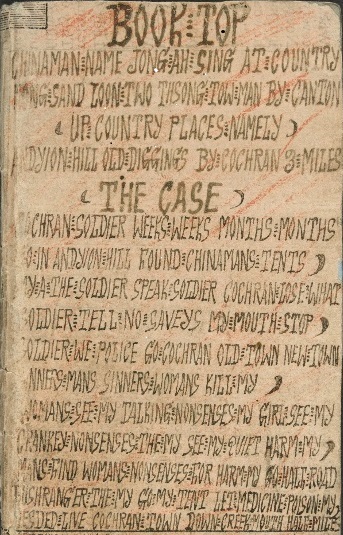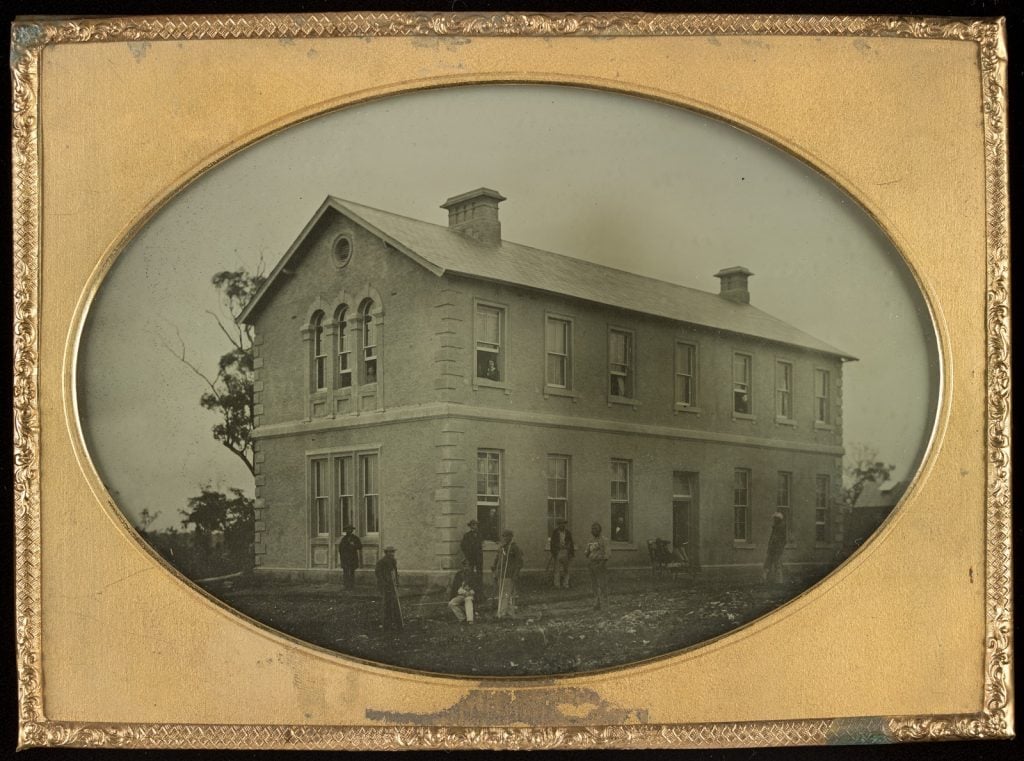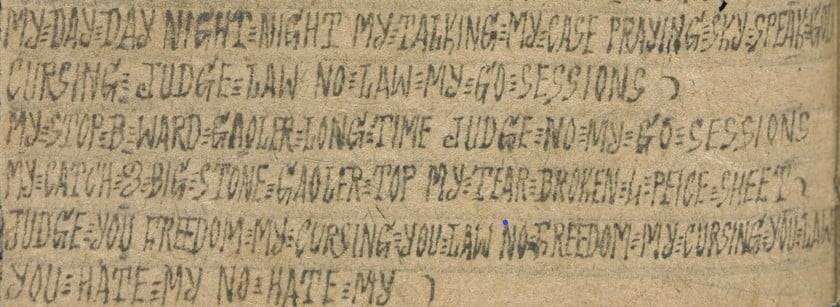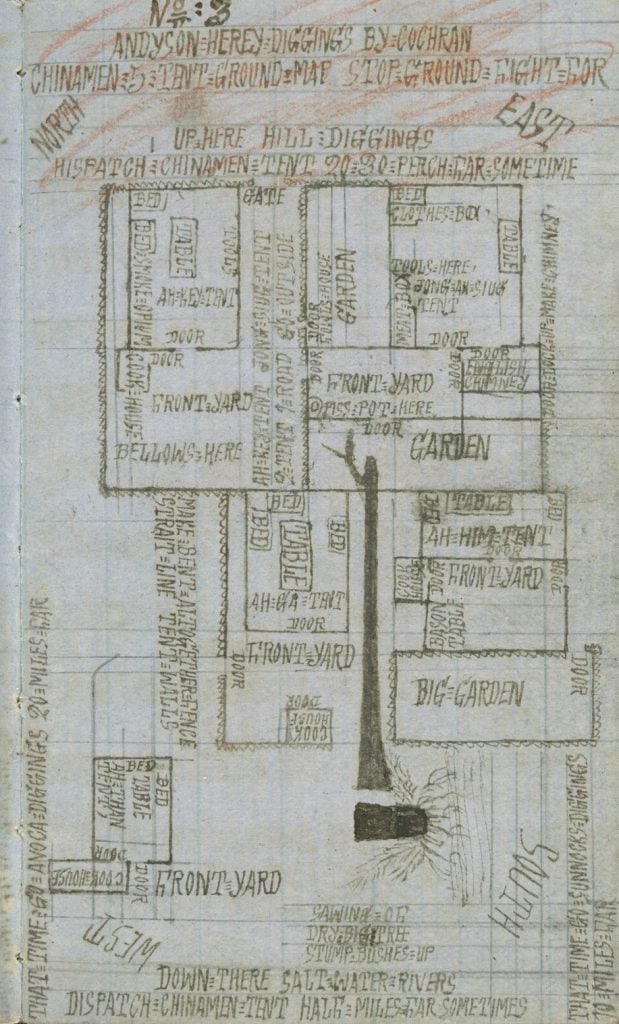A Chinese man named Jong Ah Siug came to Victoria in the 1850s to find gold. After a number of incidents he found himself in jail and eventually transferred to the Yarra Bend Asylum, then onto the Sunbury Asylum, where he died in 1900. During his time here, Jong kept a diary which the Library acquired in 1880. The diary includes recollections of his life on the goldfields of Avoca, Cochrane and Dunolly and his experiences in the Dunolly jail and hospital after being wounded in a knife fight.

Diary, MS 12994. Above is the front page of the diary. ‘Book – top’ is translated to ‘the beginning of the book.’
The diary is very small; 10 cm high, 6 cm wide, but the writing is incredibly neat and each page is meticulously organised- which may tell us as much about the author’s mindset as the words on the page. It looks more like an expressionist work than a documentary recording- each page confessing the author’s dedication and determination under such trying circumstances.
The diary was written at the Yarra Bend Asylum in the 1870s and it is Jong’s attempt to explain his side of ‘the case’- as he puts it, which was series of incidents which lead to his jailing and long-term hospitalization. Jong believed he was wronged and unlawfully incarcerated.
The diary is very difficult to follow and not always in chronological order. English was the author’s second language and the words are not in sentences or phrases; for example: ‘Soldier- Tell- No- Saveys My- Mouth- Stop’ is translated to I spoke to the soldier. He said he did not understand me and told me to be quiet. (Moore and Tully p. 67)
We are very fortunate there is a companion book to the diary, titled A difficult case : an autobiography of a Chinese miner on the central Victorian goldfields, which has translated or interpreted the manuscript. The authors’ state that [they were] trying to deduce what he [Jong] was trying to say (p. ix).

When Jong arrived at the goldfields circa 1855, he spent time gold mining at Anderson Hill, about an hour north of Ballarat, along with many other Chinese. The diary includes hand drawn maps of the Chinese camp and the surrounding district. Jong’s tent is on the top right of the below diagram and the tent of the man he fought with, Ah Key, is top left. The map also includes ‘smoke opium’ near Ah Key’s bed and a ‘big tree stump’.
In 1867 Jong had a knife fight with several other Chinese miners. Jong claimed that the Chinese men had killed his fowl and tried to kill him. Jong fought and wounded them and also suffered self-inflicted wounds. As a result of his wounds Jong was admitted to Dunolly Hospital where he was charged with unlawfully and maliciously wounding Ah Kay. The case was tried in the Dunolly Police Court and the jury acquitted Jong on the grounds that he was of unsound mind. He was held in the Maryborough jail.



During his time in hospital Jong claimed the doctor had cut him and tried to kill him.
Then the doctor spoke to the police and they untied my legs and by day let me sit and walk. At night they locked one of my arms to the bedstead with handcuffs. (Moore and Tully p. 99)
and he wrote that he saw God;
In the middle of the room a big lamp burned half the night. God came to the room. Taa To Tom was the God. He made the lamp burn up very bright and blacken the shade although it was not broken. I saw the sky God on 2 or 3 nights.
(Moore and Tully p. 97)
Jong was sent to Melbourne Gaol, where he was diagnosed with chronic mania, then transferred to Yarra Bend Asylum in 1860, where he stayed for ten years, and where he wrote this diary. The diagrams and maps in the diary illustrate the vivid memories of his time on the goldfields. Despite having a limited clasp of English he was determined to record his story. He pleaded for another trial:
Day after day and night after night I spoke of my case, prayed to the sky and spoke to God. I cursed the judge and the law … Judge, I curse you for taking away my freedom by your law … I have died in gaol and I am the devil … Judge, you hate me. I would thank you Judge to open the sessions and take me to be tried.
(Moore and Tully p. 113)

Jong was recorded as being in good health and well-behaved during his twenty-one years in the Sunbury Asylum. After a brief illness, he died there in 1900. The diary provides a very specific portrait of Jong- the way he catalogued events and places; each piece of furniture in the tent and the hospital is drawn and labelled- it did exist, it wasn’t just in his head. Perhaps to Jong, his life made more sense on paper- it was no longer a tornado of thoughts and actions confused by a second language in a foreign land. He needed to express his frustrations but was not confident his spoken words were getting through. The diary becomes practical proof of his past and presents his world as the truth- and reveals a man trying to understand what had happened to his life.
Whilst the diary is a fascinating work, it is made all the more accessible by Ruth Moore and John Tulley’s translation, annotations and historical information in A difficult case : an autobiography of a Chinese miner on the central Victorian goldfields.
You can view the diary online and also explore more gold rush resources in a dedicated research guide.
Note- the use of the name ‘Siug’, rather than ‘Sing’ is based on a note on page 65 of A difficult case. The translation states, ‘on the first page [of the Diary] he [Jong] uses the name Jong Ah Sing, elsewhere he consistently uses Ah Siug. We have chosen to use ‘Ah Siug throughout.’



Hi Paul, great blog, thank you. Sorry I took so long to know about it. A small but important correction. His name should be written as Jong Ah Sing, which is how he himself wrote it. For some strange reason when John Tully published the diary 30 years ago, he misread the last word as Siug. Sing makes sense as a name in Cantonese. Siug does not sound Cantonese.
Hi Paul,
Thanks for reading the blog. I think I address this is in the last part of the blog:
Note- the use of the name ‘Siug’, rather than ‘Sing’ is based on a note on page 65 of A difficult case. The translation states, ‘on the first page [of the Diary] he [Jong] uses the name Jong Ah Sing, elsewhere he consistently uses Ah Siug. We have chosen to use ‘Ah Siug throughout.’
Although it states Sing on the front page… in the other pages he refers to himself as Siug.
Paul